Thermal Energy Transfer
Improving Heat Pump Performance Through Thermal Energy Transfer

Dive into the world of **boosting heat pump performance** by mastering the art of moving warmth around. Imagine turning up the cozy in your home without breaking the bank. This adventure suits anyone eager to slash their heating bill and treat the planet kindly. Packed with nifty tricks and lesser-known facts, you’ll find out how to make your heat pump work like a charm. Slicing through technical jargon, let’s unveil the secrets behind cranking up the heat efficiently. You’ll leave equipped with the know-how to keep your space toasty for less. Stick around, and let’s heat things up with knowledge that pays off!
In this article, we will delve into the basics of thermal energy transfer, understand heat pump efficiency, and discuss the crucial role of thermal energy transfer in optimizing heat pump performance.
By examining various factors affecting thermal energy transfer and exploring advanced techniques, we aim to help you maximize heat pump efficiency and serve your needs effectively.
Key Takeaways
- Understanding the basics of thermal energy transfer is crucial for optimizing heat pump performance.
- Efficient thermal energy transfer methods in heat pumps reduce energy consumption and promote sustainability.
- Strategies for enhancing thermal energy transfer include fluid flow optimization, proper insulation placement, and well-designed heat exchangers.
- Advanced techniques for thermal energy transfer in heat pumps include the use of nanofluids, enhanced thermal conductivity, and intelligent control systems.
The Basics of Thermal Energy Transfer
First, let’s understand the three basic methods of thermal energy transfer.

Heat transfer mechanisms play a vital role in heat pump operation.
The first method is conduction, which involves the transfer of heat through direct contact between materials. In this process, heat flows from a higher temperature region to a lower temperature region.
The second method is convection, where heat is transferred through the movement of fluids such as air or water. This can occur through natural convection, driven by temperature differences, or forced convection, aided by fans or pumps.
The third method is radiation, which involves the transfer of heat through electromagnetic waves. Unlike conduction and convection, radiation can transfer heat even in a vacuum.

Understanding these heat transfer mechanisms is crucial in optimizing heat pump performance and ensuring efficient energy utilization.
Understanding Heat Pump Efficiency
To truly comprehend heat pump efficiency, we must understand the relationship between the energy input and the desired thermal output. Heat pump efficiency refers to the ability of a heat pump system to convert the energy input into useful thermal energy output effectively.
There are various strategies for increasing efficiency, such as optimizing the design and size of the heat pump, using high-efficiency components, and implementing advanced control algorithms.
Proper maintenance also plays a crucial role in maximizing heat pump efficiency. Regular inspections, cleaning, and servicing of the heat pump system can prevent energy wastage and ensure that the system operates at its peak performance.

By employing these strategies and benefiting from proper maintenance, heat pump efficiency can be significantly improved.
With this understanding of heat pump efficiency, we can now delve into the role of thermal energy transfer in heat pump performance.
The Role of Thermal Energy Transfer in Heat Pump Performance
Efficient heat transfer methods play a crucial role in the overall performance of a heat pump system. By effectively transferring thermal energy, heat pumps can achieve higher levels of efficiency and reduce energy consumption.
Enhancing heat pump efficiency through optimized thermal energy transfer is essential for maximizing the system’s performance and minimizing its environmental impact.
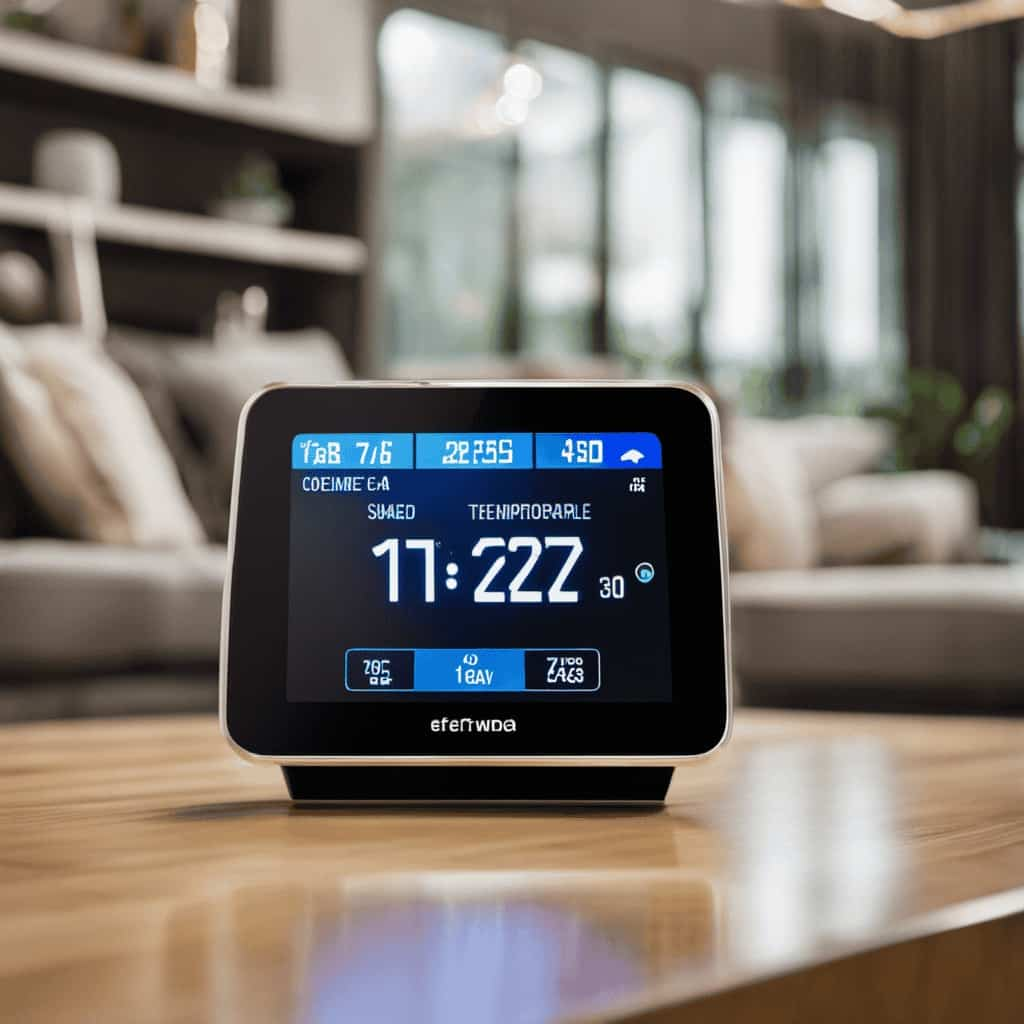
Efficient Heat Transfer Methods
One of the key factors in optimizing heat pump performance is implementing efficient heat transfer methods. By using efficient heat transfer materials and improving heat pump design, we can enhance the overall efficiency and effectiveness of heat transfer within the system.
Here are four important methods for achieving efficient heat transfer:
-
Enhanced Surface Area: Increasing the surface area of heat transfer surfaces allows for more contact between the working fluid and the heat source or sink, resulting in improved heat transfer rates.
-
Enhanced Fluid Flow: Utilizing techniques such as turbulence promoters or special flow patterns can enhance fluid flow, promoting better heat transfer by reducing boundary layer thickness and increasing convective heat transfer.

-
Improved Insulation: Proper insulation minimizes heat loss, ensuring that the heat transfer process remains efficient and effective.
-
Optimized Heat Exchanger Design: Careful design of heat exchangers, including the choice of materials, size, and configuration, can significantly improve heat transfer efficiency.
Implementing these efficient heat transfer methods can lead to higher heat pump performance, reducing energy consumption and improving overall system efficiency.
Impact on Energy Consumption
Our study reveals that implementing efficient thermal energy transfer methods in heat pumps can have a significant impact on our energy consumption. By employing strategies for reducing energy consumption through thermal energy transfer, heat pumps can operate more effectively and efficiently, resulting in lower energy usage.

The role of thermal energy transfer in heat pump performance is especially crucial when considering the impact of weather conditions on energy consumption. During extreme weather conditions, such as hot summers or cold winters, the demand for heating and cooling increases significantly, leading to higher energy consumption. However, with efficient thermal energy transfer methods in place, heat pumps can effectively manage these demands, reducing overall energy consumption and promoting sustainability.
With this understanding, we can now explore ways to further enhance heat pump efficiency and maximize energy savings.
Enhancing Heat Pump Efficiency
By implementing specific thermal energy transfer techniques, we can enhance heat pump efficiency by up to 20%. Optimizing energy transfer is crucial in improving heat pump performance. Here are four key strategies to enhance heat pump efficiency:
-
Heat exchangers: Incorporating high-efficiency heat exchangers can maximize heat transfer between the refrigerant and the surrounding environment. This reduces energy waste and improves overall system performance.
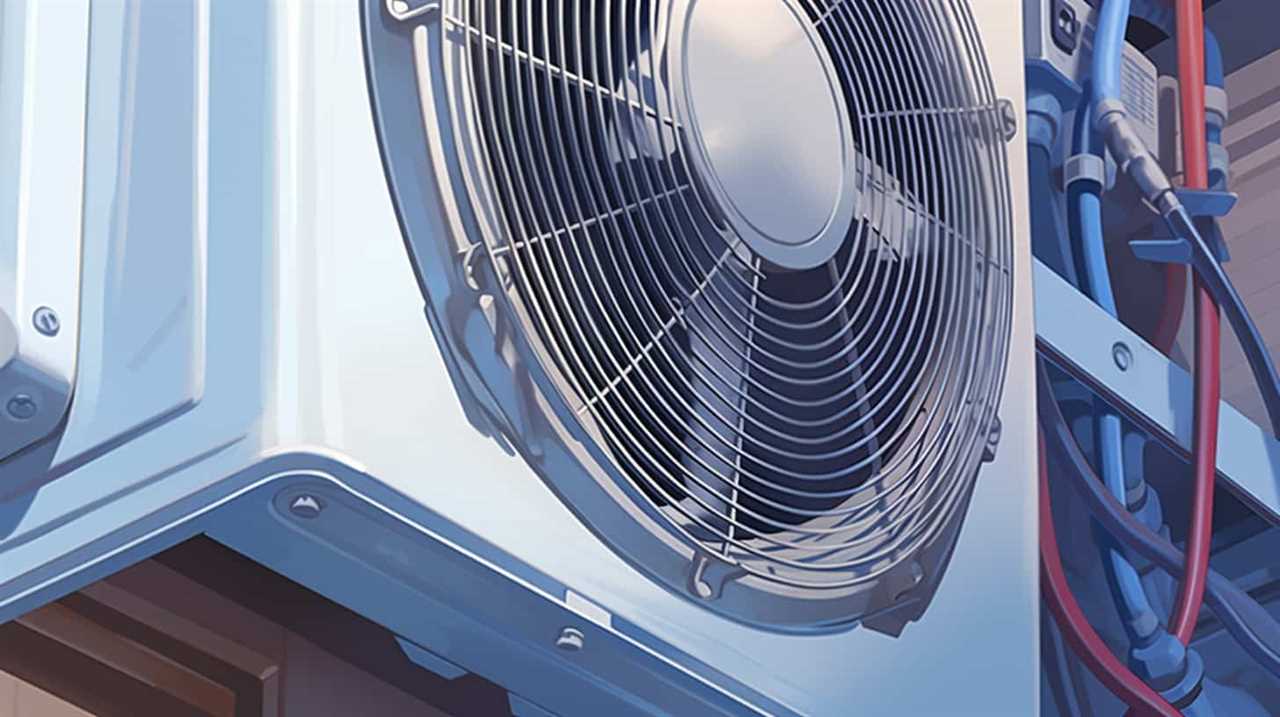
-
Insulation: Proper insulation minimizes heat loss during the transfer process, ensuring that the desired temperature is maintained efficiently.
-
Variable speed technology: Utilizing variable speed compressors and fans allows the heat pump to adjust its output according to the specific heating or cooling requirements, optimizing energy consumption.
-
Heat recovery systems: Implementing heat recovery systems can harness and reuse waste heat, further improving energy efficiency.
Factors Affecting Thermal Energy Transfer in Heat Pumps
To understand the factors influencing thermal energy transfer in heat pumps, we must consider the various components and their specific roles in the process. Two key factors that impact thermal energy transfer are fluid flow optimization and heat transfer analysis.
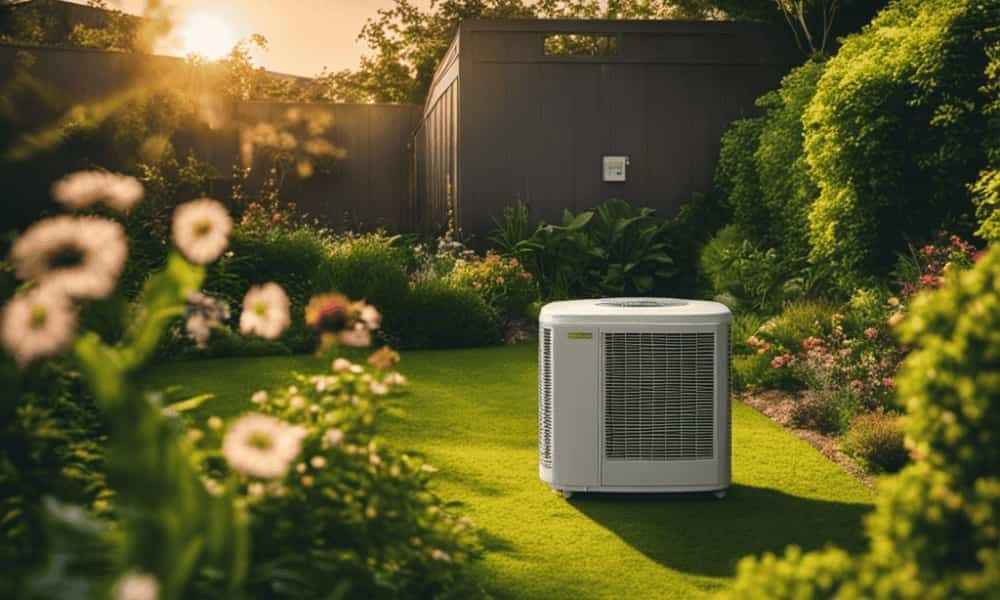
Fluid flow optimization involves designing the heat pump system in a way that maximizes the flow of the working fluid, minimizing any restrictions or inefficiencies. This can be achieved through careful selection of pipe sizes, pump capacities, and valve configurations.
Heat transfer analysis, on the other hand, focuses on understanding how heat is transferred between the working fluid and the surrounding environment. By analyzing factors such as temperature differentials, surface area, and thermal conductivity, we can identify areas for improvement and implement strategies to enhance heat transfer efficiency.
By considering these factors, we can enhance thermal energy transfer in heat pumps and improve overall system performance.
Next, let’s explore another important aspect of improving heat pump efficiency: enhancing thermal energy transfer through proper insulation.

Enhancing Thermal Energy Transfer Through Proper Insulation
One crucial step in enhancing thermal energy transfer is to ensure proper insulation for the heat pump system. Insulation materials play a significant role in minimizing heat loss and improving energy efficiency.
Here are four key factors to consider when selecting insulation materials for a heat pump system:
-
Thermal conductivity: Choose materials with low thermal conductivity to minimize heat transfer through the insulation.
-
Thickness: Opt for insulation with an appropriate thickness to provide sufficient resistance to heat transfer.

-
Moisture resistance: Select insulation materials that have good moisture resistance properties to prevent moisture buildup, which can degrade their thermal performance.
-
Insulation placement: Properly install insulation to cover all exposed areas of the heat pump system, including pipes, ducts, and the unit itself, to minimize heat loss.
Strategies for Optimizing Heat Pump Performance Through Thermal Energy Transfer
Maximizing heat pump performance can be achieved by implementing effective strategies for optimizing thermal energy transfer.
One such strategy is ensuring proper airflow within the heat pump system. By maintaining a consistent and unrestricted flow of air, heat transfer efficiency can be maximized. Regular cleaning and maintenance of the heat pump’s air filters is crucial in preventing clogs and blockages that can impede airflow.

Additionally, proper insulation of the heat pump system can greatly enhance heat transfer efficiency. Insulating the ductwork, pipes, and equipment can minimize heat loss and improve overall energy efficiency.
Another strategy is to consider the location of the heat pump system. Placing it in a well-insulated area, away from direct sunlight and any obstructions, can further optimize heat transfer.
Importance of Proper Fluid Flow for Efficient Thermal Energy Transfer
We can improve the efficiency of thermal energy transfer by ensuring a consistent and unrestricted flow of fluid within the heat pump system. Proper fluid flow optimization is crucial for maximizing the performance of a heat pump and achieving higher levels of energy efficiency.
Here are four key reasons why proper fluid flow is important for efficient thermal energy transfer:

-
Enhanced heat transfer: By maintaining a steady and unimpeded flow of fluid, we can ensure that heat is effectively transferred between the heat source and the heat sink, maximizing the efficiency of the system.
-
Reduced pressure drop: Proper fluid flow minimizes pressure drop, which in turn reduces the energy required to circulate the fluid through the heat pump system, resulting in energy savings.
-
Prevention of fouling and corrosion: Consistent fluid flow helps to prevent the buildup of contaminants and corrosive substances, which can degrade the efficiency of the heat pump over time.
-
Improved reliability: Smooth fluid flow reduces the risk of system malfunctions and equipment failures, leading to increased reliability and reduced maintenance costs.

Heat Exchangers and Their Impact on Thermal Energy Transfer in Heat Pumps
To optimize thermal energy transfer in heat pumps, it’s essential to understand the impact of heat exchangers on the system’s efficiency. Heat exchangers play a crucial role in facilitating the transfer of heat between the working fluid and the external environment.
The design of the heat exchanger greatly affects the overall performance of the heat pump, particularly its Coefficient of Performance (COP). The COP is a measure of the heat pump’s efficiency in providing heating or cooling. A well-designed heat exchanger maximizes the heat transfer rate, resulting in a higher COP.
Factors such as the choice of materials, surface area, and flow patterns within the heat exchanger can significantly influence its effectiveness. By optimizing heat exchanger design, heat pumps can achieve higher levels of thermal energy transfer.
Now, let’s explore advanced techniques for further enhancing thermal energy transfer in heat pumps.

Exploring Advanced Techniques for Thermal Energy Transfer in Heat Pumps
The article explores advanced techniques for enhancing thermal energy transfer in heat pumps. In order to improve the performance and efficiency of heat pumps, it’s essential to explore novel materials and innovative designs. Here are four techniques that can be employed:
-
Advanced Heat Exchanger Designs: By incorporating advanced heat exchanger designs, such as microchannel heat exchangers or plate heat exchangers, the heat transfer efficiency can be significantly improved. These designs provide enhanced surface area and optimized flow patterns, resulting in improved thermal performance.
-
Phase Change Materials: By utilizing phase change materials, which have the ability to store and release large amounts of thermal energy during phase transitions, heat pumps can achieve higher heat transfer rates. These materials can be integrated into heat exchangers to enhance the overall efficiency of the system.
-
Enhanced Heat Transfer Surfaces: By incorporating specially designed surfaces with enhanced heat transfer properties, heat pumps can achieve higher heat transfer rates. These surfaces can be engineered to have increased surface area, improved wettability, or enhanced thermal conductivity, resulting in improved thermal performance.

-
Intelligent Control Systems: By implementing intelligent control systems, heat pumps can optimize the thermal energy transfer process. These systems utilize advanced algorithms and sensors to monitor and adjust various parameters, such as flow rate, temperature, and pressure, in real-time, ensuring optimal heat transfer efficiency.
Maximizing Heat Pump Efficiency Through Innovative Thermal Energy Transfer Technologies
To maximize heat pump efficiency, we can explore the use of advanced heat exchangers, nanofluids, and enhanced thermal conductivity.
Advanced heat exchangers, such as microchannel and plate heat exchangers, offer improved heat transfer rates and reduced pressure drops.
Nanofluids, which are suspensions of nanoparticles in a base fluid, have shown promise in enhancing heat transfer performance due to their unique properties.
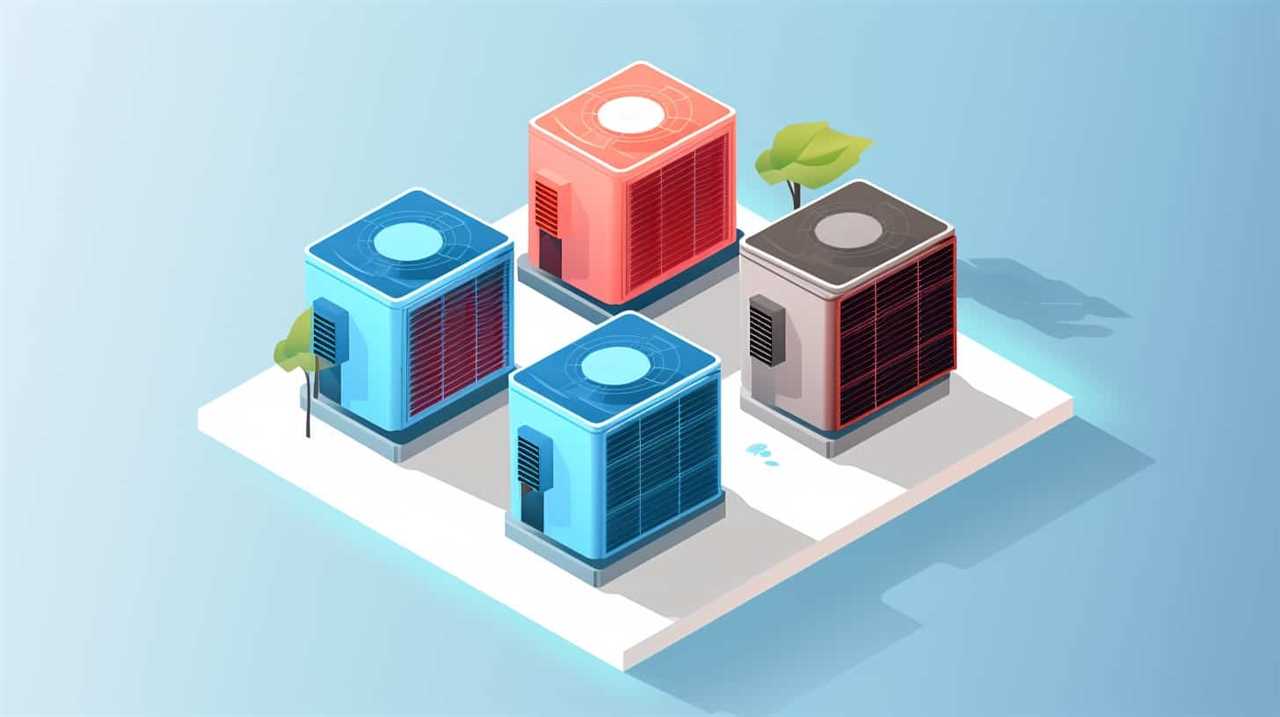
Additionally, enhancing the thermal conductivity of materials used in heat pump components can further improve overall efficiency by reducing heat losses and increasing heat transfer rates.
Advanced Heat Exchangers
Our research focuses on utilizing advanced heat exchangers to maximize the efficiency of heat pumps through innovative thermal energy transfer technologies. Advanced heat exchangers play a crucial role in improving the performance of heat pumps by enhancing heat conduction and optimizing heat exchanger design.
Here are four key aspects of advanced heat exchangers:
-
Enhanced heat conduction: Advanced heat exchangers employ materials with high thermal conductivity to facilitate efficient heat transfer. This allows for faster and more effective exchange of thermal energy between the heat pump and the surrounding environment.

-
Compact design: Advanced heat exchangers are designed to have a compact layout, reducing the overall size and volume of the heat pump system. This not only saves space but also improves the system’s efficiency by minimizing heat losses and pressure drops.
-
Counterflow arrangement: Heat exchangers with a counterflow arrangement enable a more efficient transfer of heat by maximizing the temperature difference between the hot and cold fluids. This results in improved overall heat pump performance.
-
Surface enhancement techniques: Advanced heat exchangers incorporate surface enhancement techniques such as finning or corrugation to increase the surface area available for heat transfer. This enhances the heat transfer rate and improves the efficiency of the heat pump.
Nanofluids for Better Performance
We have discovered that incorporating nanofluids into heat pump systems can significantly enhance their performance and maximize heat pump efficiency through innovative thermal energy transfer technologies. Nanofluids are engineered fluids that consist of nanoparticles dispersed in a base fluid, such as water or oil. These nanoparticles, with their unique properties, can greatly improve heat transfer rates compared to traditional heat transfer fluids.

Table: Nanofluid Properties and Applications in Refrigeration
| Nanofluid Property | Applications in Refrigeration |
|---|---|
| High thermal conductivity | Improved heat transfer in heat exchangers |
| Enhanced convective heat transfer | Increased heat dissipation in refrigeration systems |
| Increased boiling and condensation heat transfer coefficients | More efficient heat transfer during phase change processes |
| Improved stability and dispersion | Long-term reliability and performance in heat pump systems |
Enhanced Thermal Conductivity
By incorporating innovative thermal energy transfer technologies, we can enhance the thermal conductivity of heat pumps and maximize their efficiency. Here are four ways to achieve this:
-
Utilize new materials: Researchers are constantly developing materials with high thermal conductivity, such as graphene and carbon nanotubes. By incorporating these materials into the heat pump design, we can improve heat transfer efficiency and maximize conductivity.
-
Implement advanced heat exchangers: Heat exchangers play a crucial role in transferring thermal energy between the heat pump and the surrounding environment. By using advanced heat exchanger designs, such as microchannel heat exchangers or plate heat exchangers, we can increase the surface area available for heat transfer, thereby enhancing thermal conductivity.

-
Optimize refrigerant properties: The choice of refrigerant can greatly impact the thermal conductivity of a heat pump. By selecting refrigerants with higher thermal conductivity and lower viscosity, we can maximize heat transfer efficiency and improve overall performance.
-
Enhance system insulation: Proper insulation is essential for minimizing heat loss in a heat pump system. By using high-quality insulation materials and reducing thermal bridging, we can minimize energy losses and improve the overall thermal conductivity of the system.
Case Studies: Successful Applications of Thermal Energy Transfer to Improve Heat Pump Performance
Several successful case studies demonstrate the effectiveness of thermal energy transfer in improving heat pump performance.
These case study examples provide real-world applications that showcase the benefits of utilizing thermal energy transfer techniques.

In one case study, a residential heat pump system was retrofitted with a thermal energy transfer device, resulting in a significant improvement in energy efficiency and overall performance.
Another case study involved the implementation of a thermal energy storage system in a commercial building, which resulted in reduced energy consumption and lower operating costs.
Additionally, a case study conducted on a geothermal heat pump system showed that incorporating thermal energy transfer techniques increased the system’s efficiency and reduced its reliance on auxiliary heating sources.
These successful applications highlight the practicality and effectiveness of thermal energy transfer in improving heat pump performance in various settings.

Frequently Asked Questions
What Are the Different Types of Heat Pumps?
There are two main types of heat pumps: geothermal heat pumps and air source heat pumps. Geothermal heat pumps utilize the constant temperature of the earth to transfer heat, while air source heat pumps extract heat from the air.
How Does the Size of a Heat Pump Affect Its Performance?
The size of a heat pump directly impacts its performance. Factors such as efficiency and energy consumption are influenced by the size of the heat pump. A larger heat pump can provide greater heating or cooling capacity.
What Are the Common Problems or Challenges in Thermal Energy Transfer in Heat Pumps?
Common challenges in thermal energy transfer in heat pumps include insufficient heat exchange surface area, low heat transfer coefficients, and suboptimal refrigerant flow rates. Efficiency improvements can be achieved through optimization of these factors.
How Can Weather Conditions Impact the Efficiency of Thermal Energy Transfer in Heat Pumps?
Weather conditions can significantly impact the efficiency of thermal energy transfer in heat pumps. By optimizing the system to adapt to varying temperatures, we can ensure optimal performance and enhance the overall efficiency of the heat pump.

Are There Any Regulations or Standards for Thermal Energy Transfer in Heat Pumps?
Yes, there are regulations and standards for thermal energy transfer in heat pumps. These include testing methods for heat pump performance to ensure efficiency and reliability. Compliance with these regulations is necessary for safe and effective operation.
Conclusion
In conclusion, we’ve explored the importance of thermal energy transfer in heat pump performance and the various factors that can affect it.
While proper insulation and heat exchangers play a significant role in enhancing this transfer, advanced techniques and innovative technologies hold the key to maximizing heat pump efficiency.
It’s ironic that by focusing on the intricate details of thermal energy transfer, we can achieve greater complexity and depth in improving heat pump performance.

Thermal Energy Transfer
Boost Heat Pump Efficiency: Renewable Energy’s Unexpected Power

Are you prepared to unleash the complete capabilities of your heat pump? Search no more! In this article, we will delve into the surprising impact of renewable energy on enhancing heat pump effectiveness.
Get ready to revolutionize your heating system as we delve into the role of solar energy, harnessing geothermal power, the game-changing wind energy, sustainable biomass solutions, and the untapped potential of hydropower.
Prepare to master the art of maximizing heat pump performance with the help of renewable energy sources.
Key Takeaways
- Solar panel integration allows for the direct conversion of sunlight into electricity, reducing reliance on traditional power sources.
- Geothermal energy can maximize heat pump performance by providing heat stored beneath the Earth’s surface, leading to higher levels of efficiency.
- Wind power can revolutionize heat pump efficiency by generating electricity to power heat pumps, reducing their carbon footprint.
- Biomass combined with heat pump technology greatly enhances efficiency and sustainability, reducing reliance on fossil fuels and emitting fewer greenhouse gases.
The Role of Solar Energy in Enhancing Heat Pump Efficiency
We can enhance heat pump efficiency by utilizing solar energy. Solar panel integration plays a crucial role in harnessing renewable energy for heat pumps. By connecting solar panels to heat pump systems, we can directly convert sunlight into electricity, reducing reliance on traditional power sources. This integration allows heat pumps to operate more efficiently, as they can draw power from the solar panels during daylight hours.

Additionally, energy storage solutions can further optimize heat pump performance. Storing excess solar energy in batteries or other storage systems ensures a continuous power supply for heat pumps, even when sunlight is limited.
This combination of solar panel integration and energy storage solutions maximizes the utilization of renewable energy, significantly improving heat pump efficiency.
Harnessing Geothermal Power to Maximize Heat Pump Performance
One way to maximize heat pump performance is by harnessing the power of geothermal energy. Geothermal energy is heat that is stored beneath the Earth’s surface in geothermal reservoirs. This heat can be extracted and used to provide heating and cooling for buildings. Geothermal innovations have made it possible to tap into this renewable energy source and optimize the efficiency of heat pumps.
By utilizing geothermal energy, heat pumps can achieve higher levels of efficiency compared to traditional heating and cooling systems. The table below illustrates the advantages of harnessing geothermal power for heat pump performance:
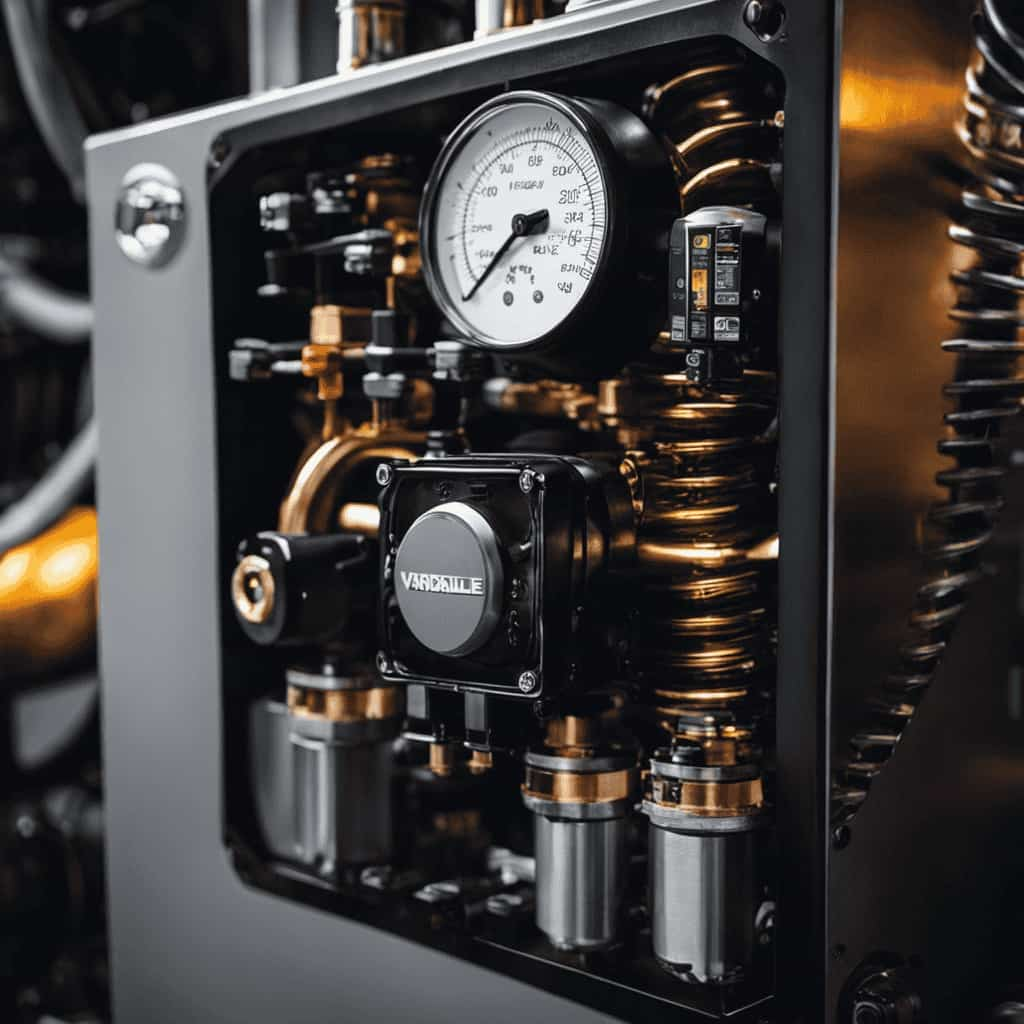
| Advantages of Geothermal Power for Heat Pump Performance |
|---|
| Higher efficiency |
| Reduced energy consumption |
| Lower operating costs |
| Environmentally friendly |
Harnessing geothermal power not only improves the performance of heat pumps but also contributes to a more sustainable and energy-efficient future. By utilizing the abundant geothermal resources available, we can maximize the efficiency of heat pumps and reduce our carbon footprint.
Wind Energy: A Game-Changer for Heat Pump Efficiency
Harnessing wind energy can revolutionize heat pump efficiency.
Wind energy has the potential to be a game changer for heat pump technology, offering significant benefits to renewable energy solutions.
By utilizing wind power to generate electricity, heat pumps can operate more efficiently and reduce their carbon footprint.

Wind turbines can produce large amounts of electricity, which can be used to power heat pumps, allowing them to operate at higher efficiencies.
Additionally, wind energy is a clean and renewable source, making it an environmentally friendly option for heat pump systems.
The integration of wind energy into heat pump technology enhances the overall performance and sustainability of these systems.
Biomass: A Sustainable Solution for Boosting Heat Pump Efficiency
Using biomass as a renewable fuel source and combining it with heat pump technology can greatly enhance efficiency and sustainability. Biomass, which refers to organic materials such as wood, agricultural residues, and dedicated energy crops, offers a promising alternative fuel for heat pumps. By harnessing the energy stored in biomass, heat pumps can provide a reliable and efficient heating solution while reducing reliance on fossil fuels. The innovative combination of biomass and heat pump technology allows for a more sustainable heating system that emits fewer greenhouse gases and decreases overall energy consumption. To illustrate the potential benefits of this approach, consider the table below, which compares the energy efficiency and carbon emissions of biomass-powered heat pumps to conventional heating systems.
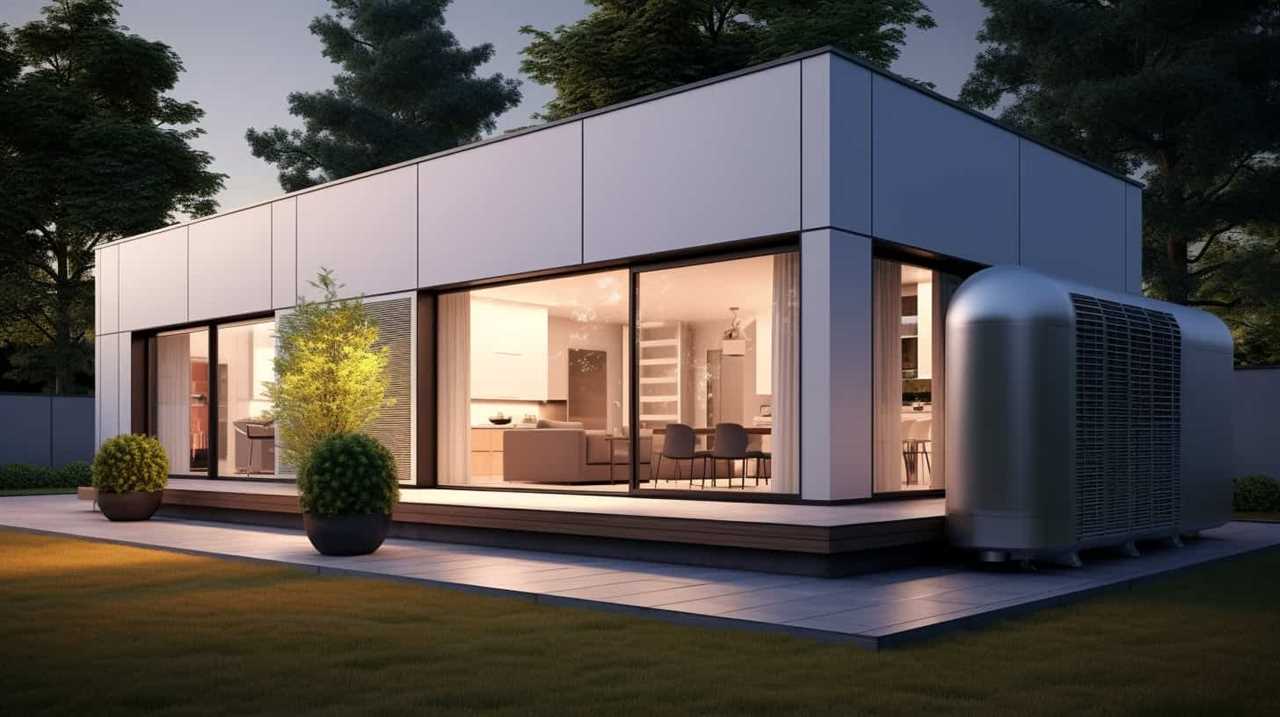
| Heating System | Energy Efficiency (COP) | Carbon Emissions (kgCO2/MWh) |
|---|---|---|
| Biomass Heat Pump | 4.5 | 10 |
| Natural Gas Boiler | 0.9 | 200 |
| Oil Boiler | 0.85 | 250 |
| Electric Resistance | 1 | 500 |
| Air-Source Heat Pump | 3 | 60 |
As shown in the table, biomass heat pumps have a significantly higher energy efficiency and lower carbon emissions compared to other heating systems. This makes them an attractive and sustainable solution for boosting heat pump efficiency.
Hydropower: Unleashing the Potential of Water to Improve Heat Pump Performance
We can maximize heat pump performance by tapping into the immense potential of hydropower, using water as a renewable energy source. Hydropower, also known as hydroelectric power, offers several advantages in improving heat pump efficiency.
- Water Efficiency:
- Hydropower utilizes the natural flow of water, harnessing its kinetic energy to generate electricity.
- This process doesn’t consume water, making it a highly water-efficient energy source.
- Heat pumps can benefit from this water efficiency by leveraging hydropower for their operations, reducing overall water consumption.
- Hydroelectric Power:
- Hydropower plants can generate a significant amount of electricity, providing a reliable and consistent power source for heat pumps.
- The scalability of hydropower allows for large-scale generation, accommodating the increasing demand for heat pump installations.
- By integrating hydropower into heat pump systems, we can enhance their performance and contribute to a more sustainable and efficient energy ecosystem.
Harnessing the power of water through hydropower can significantly improve heat pump performance, ensuring optimal energy utilization and reducing environmental impact.
Frequently Asked Questions
What Are the Key Factors to Consider When Choosing a Heat Pump for Optimal Efficiency?
When choosing a heat pump for optimal efficiency, key factors to consider include heat pump installation and heat pump sizing. These factors play a crucial role in maximizing energy efficiency and ensuring optimal performance.
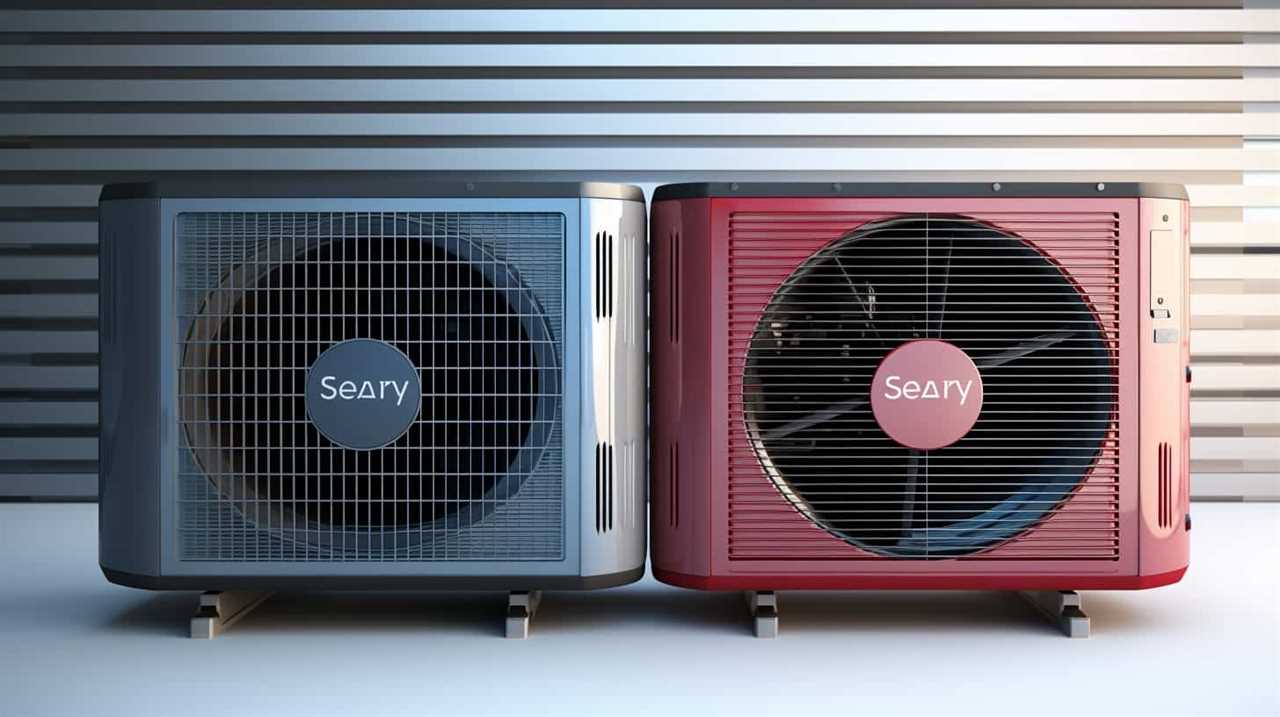
Can Heat Pumps Be Used in All Types of Climates or Are They More Suitable for Specific Regions?
Heat pumps can be used in all types of climates, but their efficiency may vary in extreme conditions. Some limitations include reduced performance in very cold regions and the need for additional heating sources.
Are There Any Government Incentives or Tax Credits Available for Installing Heat Pumps?
There are government incentives and tax credits available for installing heat pumps. These incentives can significantly reduce the upfront cost and make renewable energy more accessible to homeowners and businesses.
How Long Does It Typically Take for a Heat Pump to Pay for Itself in Terms of Energy Savings?
The heat pump payback period depends on various factors, including energy costs, climate, and insulation. It typically takes about 5-10 years for a heat pump to pay for itself in terms of energy savings.
Are There Any Maintenance Requirements or Recommended Practices to Ensure the Long-Term Efficiency of a Heat Pump?
To ensure long-term efficiency, heat pumps require regular maintenance and adherence to recommended practices. These include cleaning or replacing air filters, checking refrigerant levels, and inspecting electrical components. Neglecting these requirements can result in decreased performance and higher energy consumption.

Conclusion
In conclusion, renewable energy sources such as solar, geothermal, wind, biomass, and hydropower play a crucial role in boosting heat pump efficiency.
One interesting statistic to note is that harnessing solar energy can increase heat pump performance by up to 40%, while utilizing geothermal power can improve efficiency by up to 50%.
These renewable energy solutions not only provide sustainable alternatives to traditional heating methods but also contribute to a more energy-efficient and environmentally friendly future.
Thermal Energy Transfer
Decoding Heat Pumps’ Energy Efficiency Ratings: A Guide

Welcome to our guide on understanding the energy efficiency ratings of heat pumps! Have you ever been confused by the numbers and acronyms? We’re here to assist you.
In this article, we’ll break down the importance of energy efficiency ratings, how they’re calculated, and the key metrics to look out for.
We’ll also provide tips on maximizing your heat pump’s performance.
So, let’s dive in and uncover the secrets to choosing the most efficient heat pump for your needs.
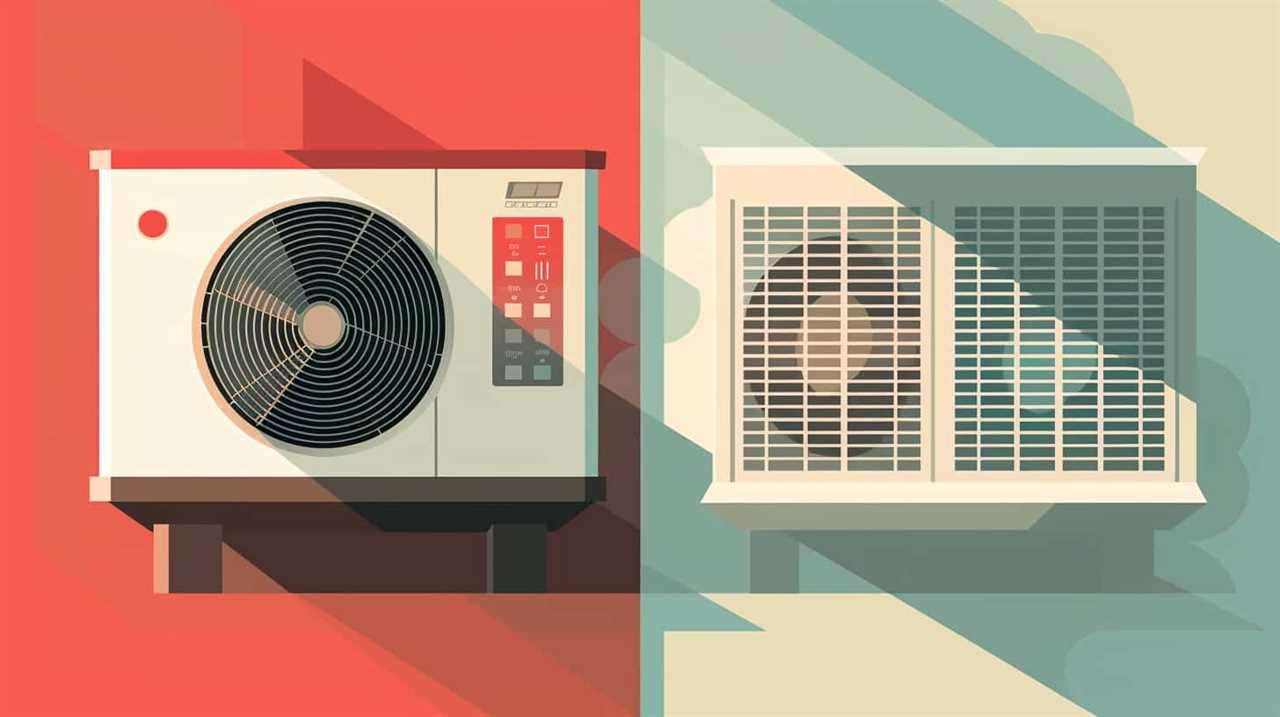
Key Takeaways
- Energy efficiency ratings are important in determining the effectiveness and cost savings of heat pumps.
- Higher efficiency ratings indicate lower energy consumption and can lead to reduced energy bills.
- Heat pumps with higher efficiency ratings often qualify for rebates and incentives.
- Evaluating energy efficiency ratings helps in making informed decisions and maximizing the benefits of heat pumps.
The Importance of Energy Efficiency Ratings in Heat Pumps
We believe that energy efficiency ratings play a crucial role in determining the effectiveness of heat pumps. When evaluating energy savings and long-term cost benefits, it’s important to consider the efficiency rating of a heat pump.
An energy efficiency rating provides a measure of how effectively a heat pump converts electricity into heat. Higher efficiency ratings indicate that the heat pump is more efficient in converting energy, resulting in lower energy consumption and ultimately, cost savings.
By choosing a heat pump with a high energy efficiency rating, homeowners can reduce their energy bills and minimize their environmental impact. Additionally, heat pumps with higher efficiency ratings often qualify for rebates and incentives, further enhancing the long-term cost benefits.
Evaluating energy efficiency ratings is therefore essential in making informed decisions and maximizing the benefits of heat pump technology.

How Energy Efficiency Ratings Are Calculated for Heat Pumps
To determine the energy efficiency rating of a heat pump, manufacturers use standardized testing procedures to measure its performance and calculate the ratio of heat output to electricity input. This calculation process takes into account various factors that affect the efficiency of the heat pump.
Here are some of the factors considered:
- Seasonal Energy Efficiency Ratio (SEER): This measures the cooling efficiency of the heat pump during the cooling season.
- Heating Seasonal Performance Factor (HSPF): This measures the heating efficiency of the heat pump during the heating season.
- Coefficient of Performance (COP): This measures the overall efficiency of the heat pump by considering both the cooling and heating modes.
Understanding SEER and HSPF: Key Energy Efficiency Metrics for Heat Pumps
SEER and HSPF are important energy efficiency metrics that help consumers understand the performance of heat pumps.
When it comes to evaluating the energy efficiency of heat pumps, it’s essential to understand the differences between SEER and HSPF ratings.

SEER, or Seasonal Energy Efficiency Ratio, measures the cooling efficiency of the heat pump. It calculates the amount of cooling output divided by the energy input over a cooling season. The higher the SEER rating, the more energy-efficient the heat pump is in cooling mode.
On the other hand, HSPF, or Heating Seasonal Performance Factor, measures the heating efficiency of the heat pump. It calculates the amount of heating output divided by the energy input over a heating season. A higher HSPF rating indicates better heating efficiency.
Both SEER and HSPF ratings are important when evaluating the energy efficiency of heat pumps. The choice between the two depends on the climate and the specific heating and cooling needs of the consumer. In warmer climates, where cooling demands are higher, SEER rating becomes more important. In colder climates, where heating demands are higher, HSPF rating is more significant.
To make an informed decision, it’s crucial to consider both SEER and HSPF ratings in order to choose a heat pump that meets your specific energy efficiency needs.

Comparing Energy Efficiency Ratings: What to Look for in Heat Pump Models
When comparing energy efficiency ratings, it’s important to regularly and carefully examine the different features of heat pump models. Here are three key aspects to consider when evaluating energy efficiency in heat pump models:
-
Seasonal Energy Efficiency Ratio (SEER): This rating measures the cooling efficiency of the heat pump. Look for a higher SEER rating, as it indicates better energy efficiency and lower operating costs during the cooling season.
-
Heating Seasonal Performance Factor (HSPF): HSPF measures the heating efficiency of the heat pump. A higher HSPF rating means better energy efficiency and lower heating costs during the heating season.
-
Energy Star Certification: Look for heat pump models that have earned the Energy Star certification. These models meet strict energy efficiency guidelines set by the Environmental Protection Agency (EPA) and can help you save on energy usage and costs.
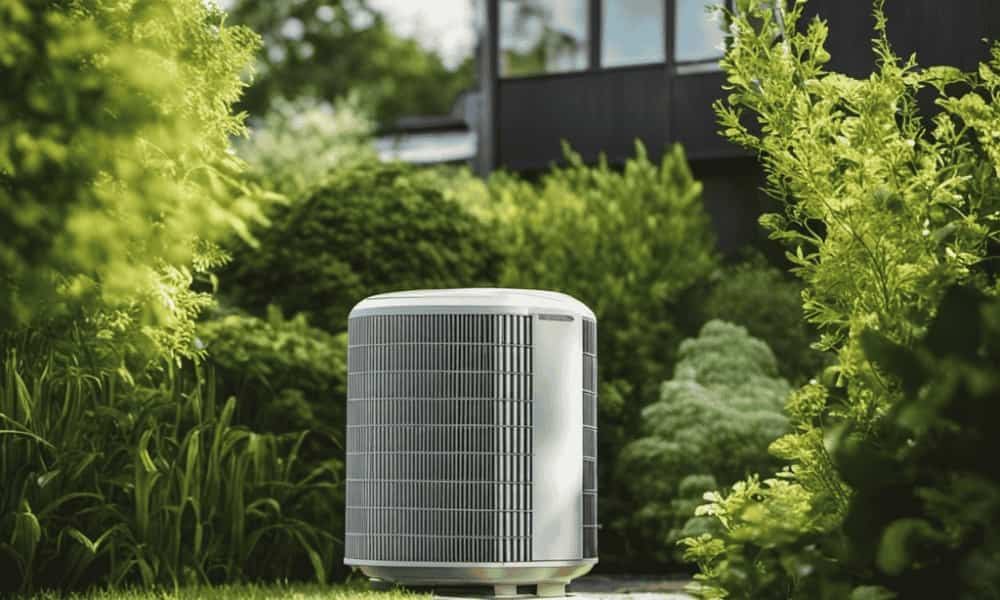
By considering these factors, you can make an informed decision when selecting a heat pump model that prioritizes energy efficiency.
In the next section, we’ll explore tips for maximizing energy efficiency and improving heat pump performance.
Maximizing Energy Efficiency: Tips for Improving Heat Pump Performance
To ensure that we get the most out of our heat pump and maximize its energy efficiency, we should implement these tips for improving its performance. First, regular maintenance is crucial for optimal operation. This includes cleaning or replacing air filters, inspecting and cleaning coils, and checking refrigerant levels. By keeping our heat pump in top condition, we can ensure that it operates efficiently and effectively. Additionally, optimizing the settings on our heat pump can make a significant difference in energy efficiency. Adjusting the thermostat to an appropriate temperature and utilizing programmable settings can help reduce energy consumption. It is also important to consider the size and placement of our heat pump, as these factors can impact its efficiency. By following these tips, we can improve the performance of our heat pump and save on energy costs.
| Tips for Improving Heat Pump Performance |
|---|
| Regular maintenance such as cleaning or replacing air filters, inspecting and cleaning coils, and checking refrigerant levels. |
| Optimizing settings on the heat pump, adjusting the thermostat to an appropriate temperature, and utilizing programmable settings. |
| Considering the size and placement of the heat pump to ensure maximum efficiency. |
Frequently Asked Questions
Are All Heat Pumps Required to Have an Energy Efficiency Rating?
Yes, all heat pumps are required to have an energy efficiency rating. Government regulations and industry standards mandate the inclusion of this rating to provide consumers with information about the product’s energy efficiency performance.

Can the Energy Efficiency Rating of a Heat Pump Change Over Time?
Yes, the energy efficiency rating of a heat pump can change over time due to various factors affecting efficiency. These factors include regular maintenance, age of the equipment, and advancements in technology.
How Can I Determine the Energy Efficiency Rating of My Existing Heat Pump?
To determine the energy efficiency rating of our existing heat pump, we can calculate the efficiency ratio by dividing the output heating or cooling energy by the input electrical energy.
Are There Any Government Incentives or Rebates Available for Purchasing a High-Efficiency Heat Pump?
Yes, there are government incentives and heat pump rebates available for purchasing a high-efficiency heat pump. These incentives and rebates can help reduce the cost and make it more affordable for homeowners to upgrade their heating systems.
Does the Location or Climate Affect the Energy Efficiency Rating of a Heat Pump?
In certain climates, heat pump efficiency ratings can be affected by the location. Additionally, proper installation is crucial for maximizing efficiency. These factors highlight the importance of considering climate and installation when evaluating a heat pump’s energy efficiency.

Conclusion
In conclusion, understanding energy efficiency ratings is crucial when evaluating heat pump options. By decoding SEER and HSPF metrics, consumers can make informed decisions that align with their energy-saving goals.
Comparing ratings and considering tips for maximizing efficiency ensures optimal performance.
Just as a skilled conductor coordinates an orchestra to create a harmonious symphony, homeowners who choose a heat pump with high energy efficiency ratings can enjoy a synchronized blend of comfort and cost savings.
Thermal Energy Transfer
Sustainable Home Design: Heat Pump Systems Efficiency Revealed
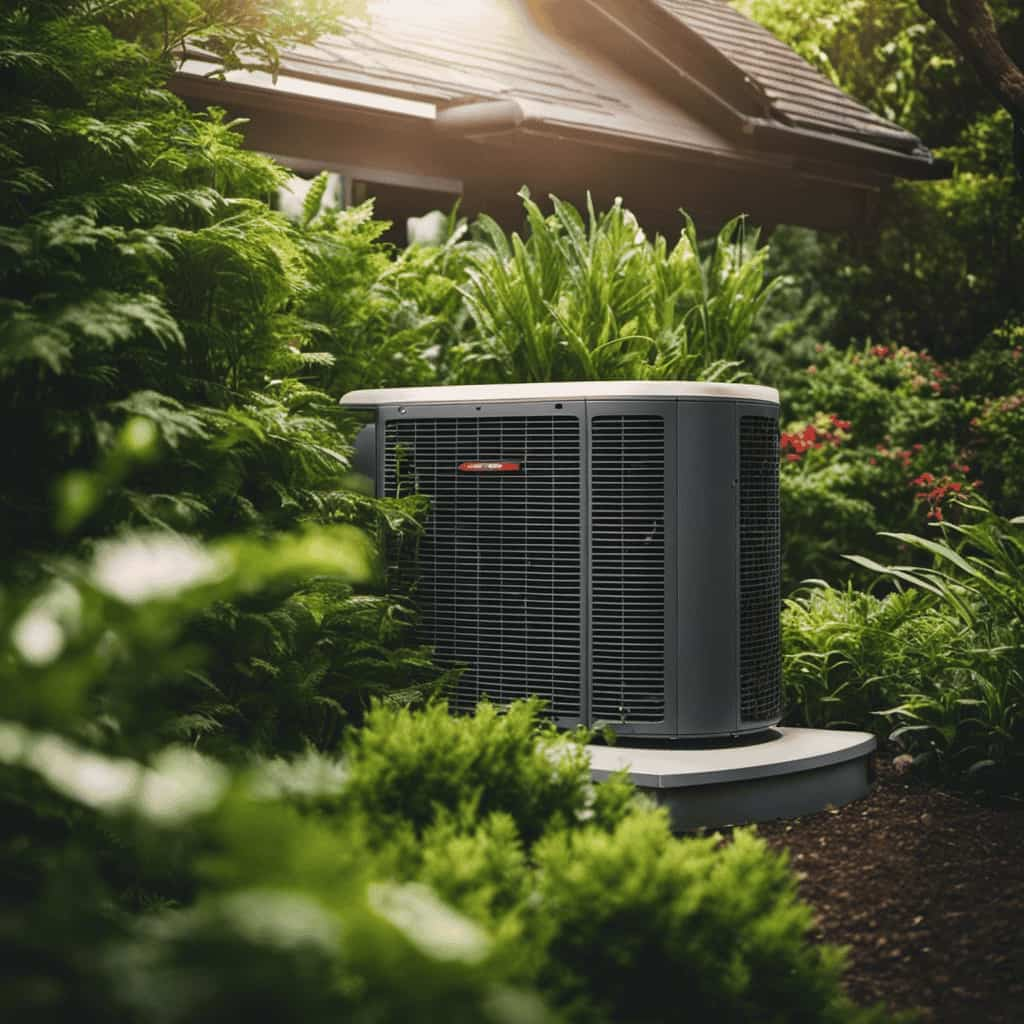
We believed we had a thorough understanding of sustainable home design, but our perspective changed when we learned about the impressive efficiency of heat pump systems.
In this article, we reveal the hidden benefits and secrets of these remarkable systems. From understanding energy efficiency ratings to tips for designing a sustainable home, we’ll guide you through the process of maximizing energy savings.
Prepare to be amazed by the innovations in heat pump technology that can transform your home into an eco-friendly haven.
Let’s dive into the world of heat pump systems and uncover their true potential.

Key Takeaways
- Heat pump systems significantly reduce energy consumption.
- Choosing a system with high SEER and HSPF ratings ensures maximum energy efficiency.
- Proper insulation and optimal system sizing are crucial for efficient heating and cooling.
- Regular maintenance helps maintain optimal system performance and energy efficiency.
The Benefits of Heat Pump Systems in Sustainable Home Design
One of the key benefits of heat pump systems in sustainable home design is that they can significantly reduce energy consumption. This advantage is especially important in today’s world, where energy efficiency is a top priority. By using heat pump systems, homeowners can lower their energy bills and reduce their carbon footprint.
Case studies have shown that these systems can achieve energy savings of up to 50% compared to traditional heating and cooling methods. Additionally, heat pump systems provide both heating and cooling capabilities, eliminating the need for separate systems and saving space.
They also offer precise temperature control and can be easily integrated with renewable energy sources such as solar panels. Overall, heat pump systems are a practical and efficient choice for sustainable home design.
Understanding Energy Efficiency Ratings for Heat Pump Systems
When it comes to understanding energy efficiency ratings for heat pump systems, we need to consider factors such as the Seasonal Energy Efficiency Ratio (SEER) and the Heating Seasonal Performance Factor (HSPF). These ratings are important in evaluating the performance of a heat pump system.

The SEER measures the cooling efficiency of the system during the cooling season, while the HSPF measures the heating efficiency during the heating season. Higher SEER and HSPF ratings indicate greater energy efficiency, which means lower energy consumption and cost savings.
It’s crucial to consider these ratings when choosing a heat pump system for your sustainable home. By opting for a system with high SEER and HSPF ratings, you can ensure maximum energy efficiency and reduce your environmental impact.
In the next section, we’ll discuss tips and considerations for designing a sustainable home with heat pump systems.
Designing a Sustainable Home With Heat Pump Systems: Tips and Considerations
To maximize the energy efficiency of our sustainable home, we should consider various tips and considerations when designing it with heat pump systems. Here are three key factors to keep in mind:

-
Proper insulation: Insulating your home effectively is crucial for reducing heat loss and ensuring that your heat pump system operates efficiently. Insulate walls, floors, and roofs to minimize heat transfer and maintain a comfortable indoor temperature.
-
Optimal system sizing: It’s important to choose the right size heat pump system for your home. Oversized systems can lead to inefficient operation, while undersized systems may struggle to meet your heating and cooling needs. Work with a professional to determine the appropriate size for your specific requirements.
-
Renewable energy integration: Consider integrating renewable energy sources, such as solar panels or wind turbines, with your heat pump system. This allows you to harness clean energy and further reduce your carbon footprint.
Maximizing Energy Savings Through Proper Heat Pump System Sizing
To maximize our energy savings, we need to ensure that our heat pump system is properly sized for our home. A heat pump that is too small will struggle to heat or cool our space efficiently, while a system that is too large will cycle on and off frequently, leading to increased energy consumption and wear and tear on the equipment. Proper heat pump sizing involves considering factors such as the size and layout of our home, insulation levels, and climate conditions. Consulting with a professional during the heat pump installation process is crucial to ensure accurate sizing. Additionally, regular heat pump maintenance, including cleaning filters and checking refrigerant levels, will help maintain optimal system performance and energy efficiency.
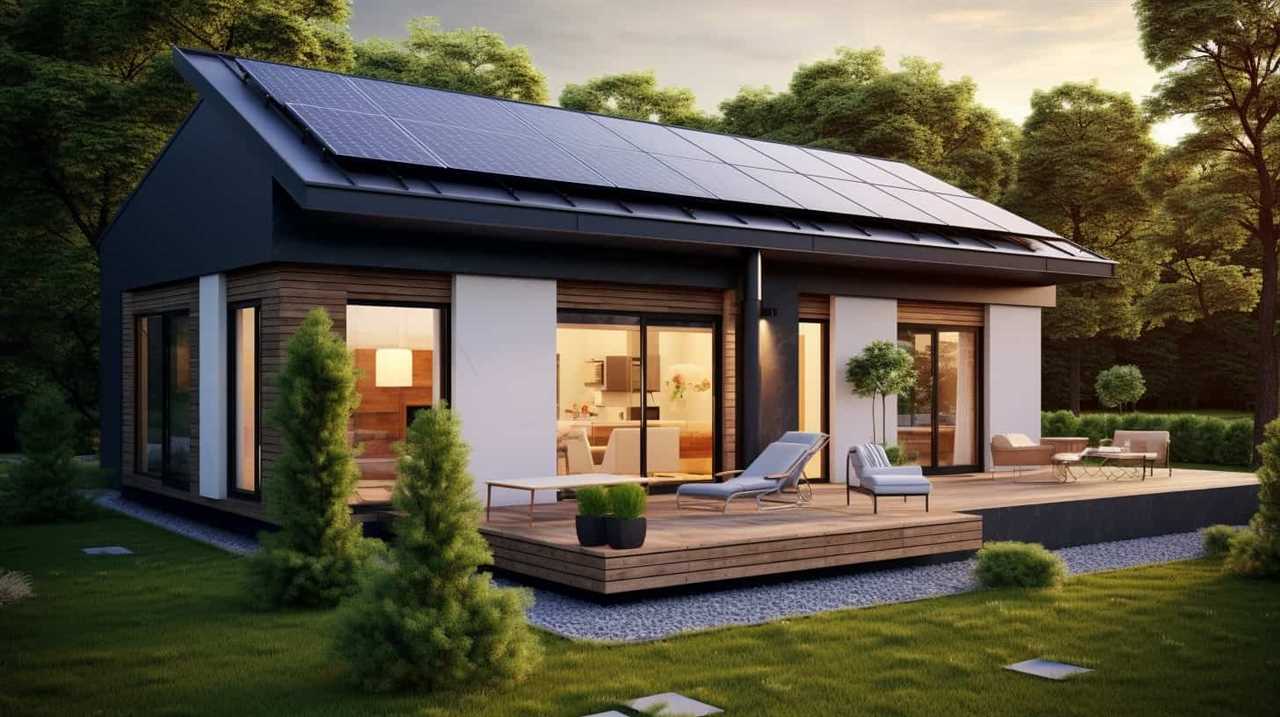
| Factors to Consider for Proper Heat Pump Sizing | |
|---|---|
| Size and layout of our home | Insulation levels |
| Climate conditions | |
| Consultation with a professional during installation | Regular heat pump maintenance |
Innovations in Heat Pump Technology for Sustainable Home Design
We have witnessed remarkable advancements in heat pump technology, revolutionizing sustainable home design. These innovations have brought about significant improvements in the efficiency and performance of heat pump systems, making them an increasingly attractive option for homeowners looking to integrate renewable energy sources into their homes.
Here are three key advancements in heat pump technology:
-
Variable speed compressors: These allow heat pumps to adjust their speed based on the heating or cooling needs of a home, resulting in more precise temperature control and increased energy efficiency.
-
Improved refrigerants: Newer heat pumps use environmentally friendly refrigerants that have a lower impact on the ozone layer and contribute less to global warming.

-
Smart controls and connectivity: Heat pumps now come equipped with smart thermostats and connectivity features, allowing homeowners to remotely control and monitor their systems, optimizing energy usage and reducing costs.
With these advancements, heat pump systems are now a reliable and efficient solution for sustainable home design, offering homeowners the opportunity to reduce their carbon footprint and save on energy bills.
Frequently Asked Questions
Are Heat Pump Systems Suitable for All Types of Homes, or Are There Specific Requirements?
Heat pump systems can be suitable for most homes, but specific requirements, such as adequate insulation and proper sizing, should be met. Consider heat pump system installation costs and the environmental impact when deciding on sustainability.
How Long Do Heat Pump Systems Typically Last Before Needing to Be Replaced?
Heat pump systems typically last around 15-20 years before needing replacement. Factors that affect their lifespan include proper maintenance, usage patterns, and the quality of the system’s components.
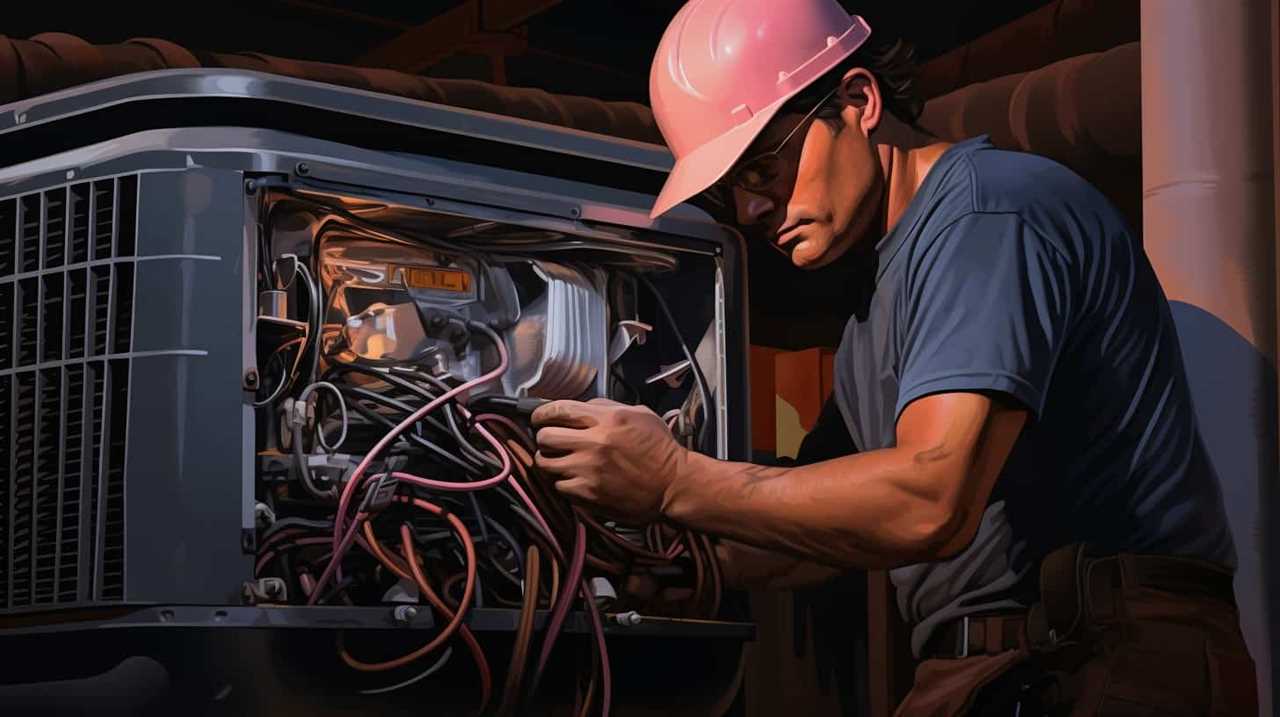
Can Heat Pump Systems Be Used for Both Heating and Cooling Purposes?
Yes, heat pump systems can be used for both heating and cooling purposes. They offer efficient temperature control in our homes. The benefits of using these systems include energy savings and a comfortable living environment.
Are There Any Government Incentives or Rebates Available for Homeowners Who Choose to Install Heat Pump Systems?
Government incentives and rebates are available for homeowners who install heat pump systems. These incentives are designed to encourage energy savings and make sustainable home design more accessible and affordable for everyone.
Are There Any Maintenance Requirements or Costs Associated With Heat Pump Systems?
Maintaining heat pump systems requires regular maintenance to ensure optimal performance. Costs associated with maintenance include filter replacements, annual inspections, and occasional repairs. However, these costs are outweighed by the long-term energy savings and environmental benefits.
Conclusion
In conclusion, heat pump systems are a symbol of efficiency and sustainability in home design.

Their energy efficiency ratings and innovative technology make them a practical choice for those seeking to reduce their environmental impact.
By properly sizing the system and considering tips for sustainable design, homeowners can maximize energy savings and create a comfortable living space.
So, let’s embrace the power of heat pump systems and build a greener future for our homes.
-

 Residential and Commercial Applications2 weeks ago
Residential and Commercial Applications2 weeks agoBest Amana Heat Pump Reviews
-

 Thermal Energy Transfer2 weeks ago
Thermal Energy Transfer2 weeks agoBreakthroughs in Modern Heat Pump Systems: Thermal Energy Edition
-

 Residential and Commercial Applications2 weeks ago
Residential and Commercial Applications2 weeks agoBest Heat Pump
-

 Geothermal Heat Pumps3 months ago
Geothermal Heat Pumps3 months agoUpgrade Your Comfort with Our Efficient HVAC Systems
-

 Air Conditioning3 months ago
Air Conditioning3 months agoExploring Energy-Efficient Air Conditioning Heat Pumps
-

 Geothermal Heat Pumps3 months ago
Geothermal Heat Pumps3 months agoInnovative Geothermal Heat Pump Manufacturers Revolutionize Energy Efficiency
-

 Thermal Energy Transfer1 month ago
Thermal Energy Transfer1 month agoBoost Your Heat Pump Efficiency: Interactive Guide
-

 Residential and Commercial Applications2 weeks ago
Residential and Commercial Applications2 weeks agoBest Portable Heat Pump Heat & AC










